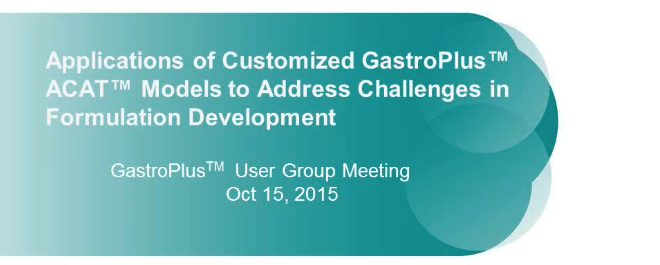SUN13837, a novel small molecule in development for the treatment of acute spinal cord injury and stroke with biological activities similar to basic fibroblast growth factor (bFGF) promotes cellular…

Discovery of novel S1P2 antagonists. Part 2: Improving the profile of a series of 1,3-bis (aryloxy) benzene derivatives
Our initial lead compound 2 was modified to improve its metabolic stability. The resulting compound 5 showed excellent metabolic stability in rat and human liver microsomes.

Simulations Plus to Launch Major New Software Product
PKPlus™ Will Provide Analysis Capability Required for Regulatory Submissions

Discovery of New Scaffolds from Approved Drugs as Acetylcholinesterase Inhibitors
Acetylcholinesterase inhibitors (AChEIs) are considered to be one of the most successful therapeutic strategies in the treatment of Alzheimer's disease (AD).

Applications of customized GastroPlus™ models
This GastroPlus™ User Group video explores how the ACAT model, with customized refinement of the model parameters or design of the model structure, can provide valuable insights to address various aspects of...

Clinical and Translational Assessment of VEGFR1 as a Mediator of the Premetastatic Niche in High-Risk Localized Prostate Cancer
Preclinical studies have suggested that VEGFR1-positive cells potentially foster the development of metastases by establishing a "premetastatic niche."

Physicochemical and Pharmacokinetic Characterization of Amorphous Solid Dispersion of Meloxicam with Enhanced Dissolution Property and Storage Stability
The aim of the present study was to develop amorphous solid dispersion (ASD) of meloxicam (MEL) for providing rapid onset of action.

Physiologically Based Pharmacokinetic Modeling of Rosuvastatin and Prediction of Transporter-Mediated Drug-Drug Interactions Involving Gemfibrozil
Rosuvastatin (Crestor®) is a commonly prescribed lipid-lowering agent from the statin drug class for the treatment of primary hyperlipidemia and hypertriglyceridemia. It may be coprescribed with...

Quantitative Approach to Predicting Human Pharmacokinetics of Monoclonal Antibody (DSP-mAbX) from Preclinical Data
DSP-mAbX is a full human monoclonal antibody targeted to a cell surface antigen. The cross-reactivity of DSP-mAbX to the target antigen in human and monkey has already been confirmed. Here, a quantitative...

Systemization of Logistic Regression Analysis for Pharmacometric Applications
Efficacy and safety data are oftentimes collected as binary (yes/no) data in clinical trials during drug development. The implementation and growing use of CDISC standards in data collection and...

Mechanistic Modeling With Dilisym® Predicts Dose-Dependent Clinical Hepatotoxicity Of Amg 009 That Involves Bile Acid Transporter Inhibition
To predict the clinical hepatotoxicity of AMG 009 and species differences in AMG 009-mediated hepatotoxicity using DILIsym®, a mechanistic model of drug-induced liver injury

Conceptual Schemas
The central focus of MBR&D is not the mathematical equations but rather the conceptual synthesis process that integrates all available information and rational extrapolations to better understand drug pharmacology in the context of the disease process.

Visualize in KIWI 1.5 – Available Now!
Speed and agility is more important than ever as the demand for M&S increases. KIWI 1.5 allows you to easily select and compare parameters estimates and diagnostic plots across multiple candidate models in one view to make decisions quickly and confidently, and delivers high quality graphs to inform team decision making and put in regulatory documents- all formatted, all validated!

Development of Physiologically Based Pharmacokinetic / Pharmacodynamic Model for Indomethacin Disposition in Pregnancy
Findings of a recent clinical study showed indomethacin has lower plasma levels and higher steady-state apparent clearance in pregnant subjects when compared to those in non-pregnant subjects reported in separate studies.

Liver-selective distribution in rats supports the importance of active uptake into the liver via organic anion transporting polypeptides (OATPs) in humans
Organic anion transporting polypeptide (OATP) 1B1 and 1B3 are key molecules that are involved in hepatic uptake related to drug elimination, and OATP-mediated drug interactions are of clinical concern.

PEGylated y-tocotrienol isomer of vitamin E: Synthesis, characterization, in vitro cytotoxicity, and oral bioavailability
Vitamin E refers to a family of eight isomers divided into two subgroups, tocopherols and the therapeutically active tocotrienols (T3).

Acute toxicity prediction in multiple species by leveraging mechanistic ToxCast mitochondrial inhibition data and simulation of oral bioavailability
There is great interest in assessing the in vivo toxicity of chemicals using nonanimal alternatives.

The use of computational chemistry to predict toxicity of antioxidants food additives and its metabolites as a reference for food safety regulation
Antioxidant food additives are used to prevent or slowing down the oxidation process in foods.

Lipidic dispersion to reduce food dependent oral bioavailability of fenofibrate: in vitro, in vivo and in silico assessments
Novel formulations that overcome the solubility limitations of poorly water soluble drugs (PWSD) are becoming ever more critical to a drug development process inundated with these compounds.

Analyzing the structural sensitivity of QSAR models using matched molecular
This video explores analyzing the structural sensitivity of QSAR models using matched molecular pairs using MedChem Studio™
